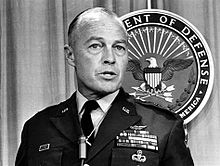Harry Kinnard
|
Lieutenant General Harry Kinnard |
|
|---|---|
 |
|
| Born |
May 7, 1915 Dallas, Texas |
| Died | January 5, 2009 (aged 93) Arlington County, Virginia |
| Place of burial | Arlington National Cemetery |
| Allegiance |
|
| Service/branch |
|
| Years of service | 1939-1969 |
| Rank |
|
| Commands held |
|
| Battles/wars | |
| Awards |
Distinguished Service Cross Distinguished Service Medal (2) Legion of Merit (2) Silver Star Bronze Star |
Harry William Osborne Kinnard II (May 7, 1915 – January 5, 2009) was an American general officer who, during the Vietnam War, pioneered the airmobile concept of sending troops into battle using helicopters. Kinnard retired from the military as a Lieutenant General.
Kinnard grew up in Dallas, Texas. After graduating from the United States Military Academy at West Point in 1939, he entered military service.
On December 7, 1941, Kinnard was stationed at Pearl Harbor, and manned a machine gun to defend the base on the morning of the Japanese attack.
He parachuted into France in the early hours of the Normandy Landings in June 1944, and was awarded the Distinguished Service Cross for his heroism during Operation Market Garden, as part of the Allied airborne attack against German forces in the Netherlands in September 1944.
In December 1944, during the Battle of the Bulge, German forces surrounded the town of Bastogne, a town in Belgium then held by the U.S. 101st Airborne Division and located at a crossroads that could have allowed the Germans to break through the American lines and reach their goal of retaking the port city of Antwerp. With the American forces surrounded, short on supplies and suffering the effects of the bitter cold weather, two German officers approached the American lines with a demand that the U.S. forces surrender or face destruction.
...
Wikipedia
